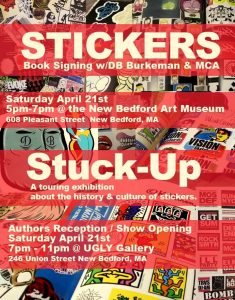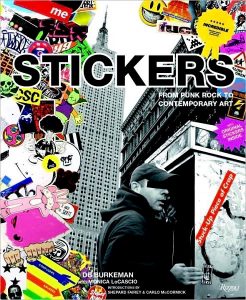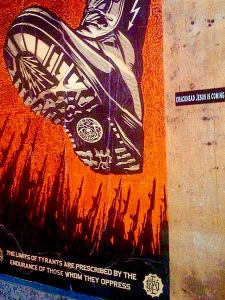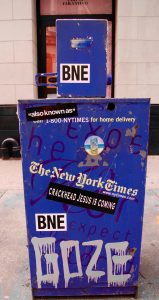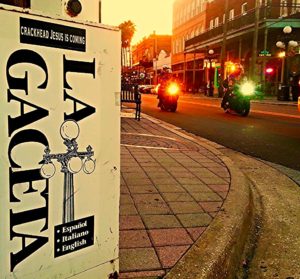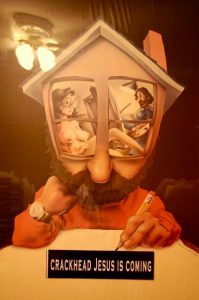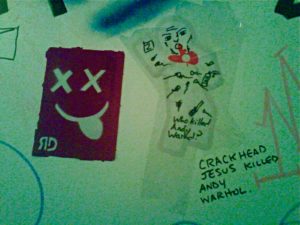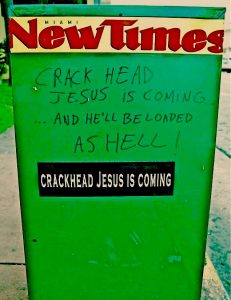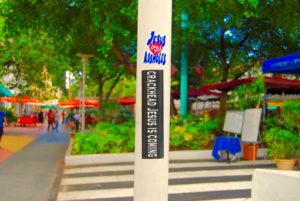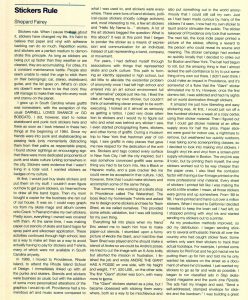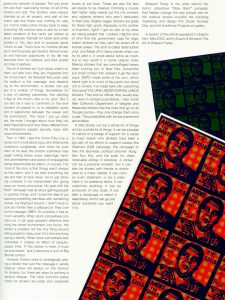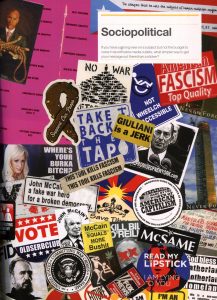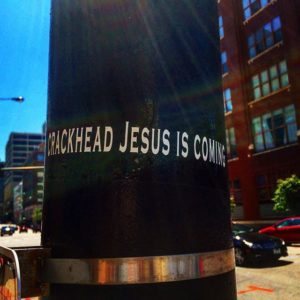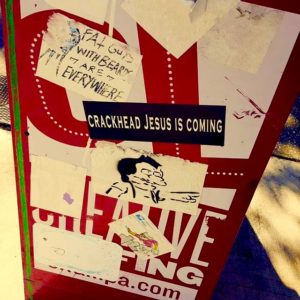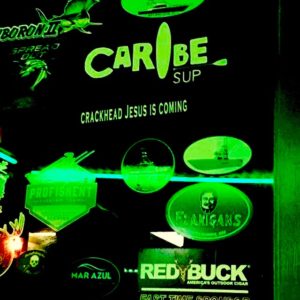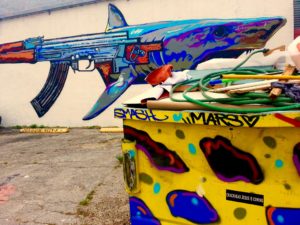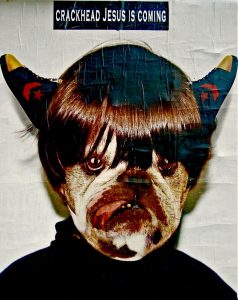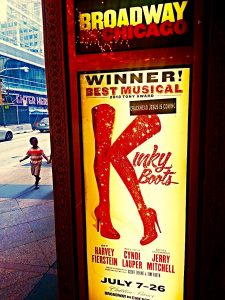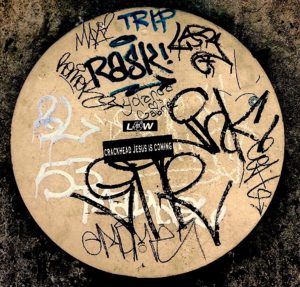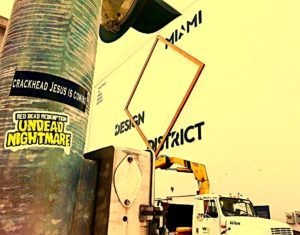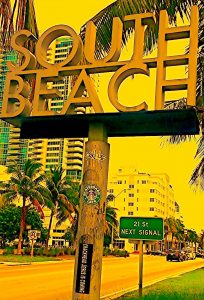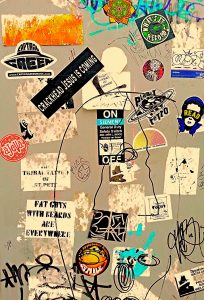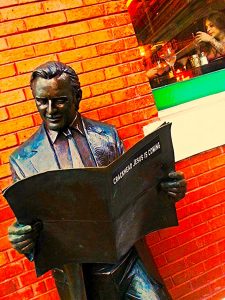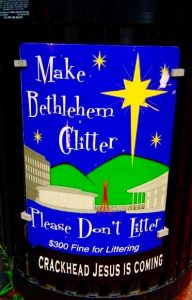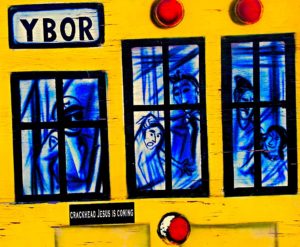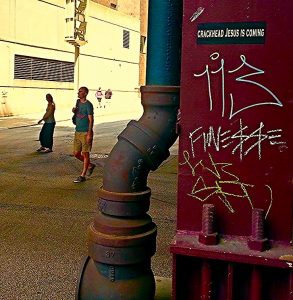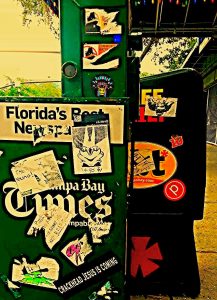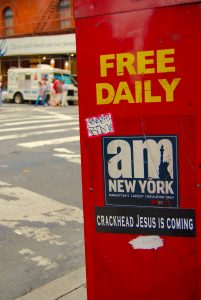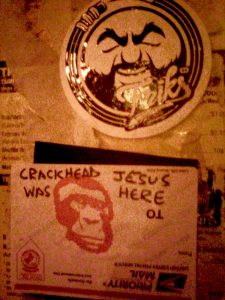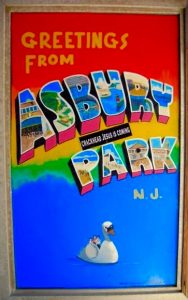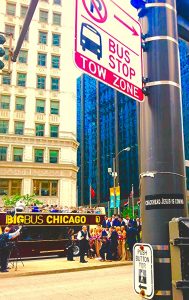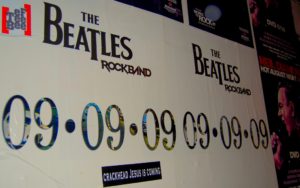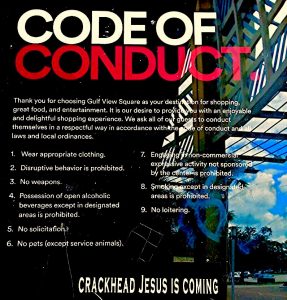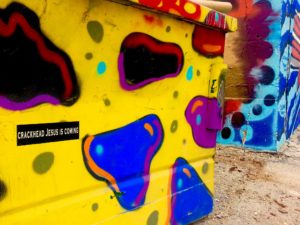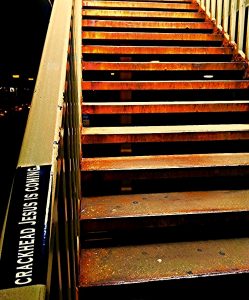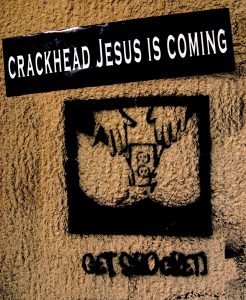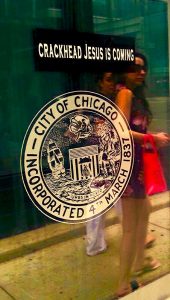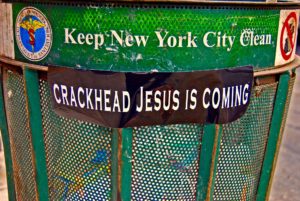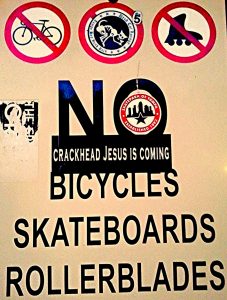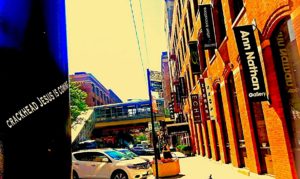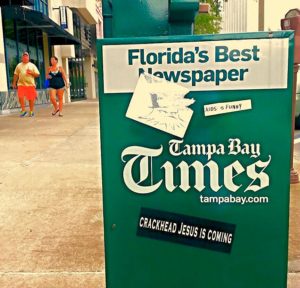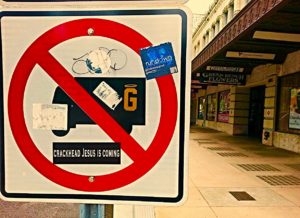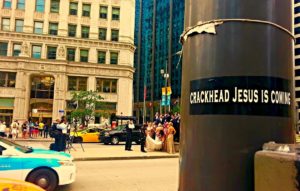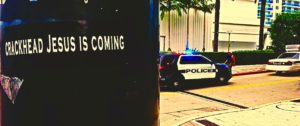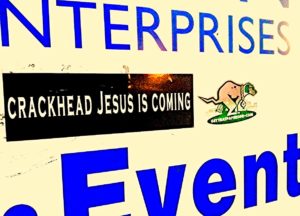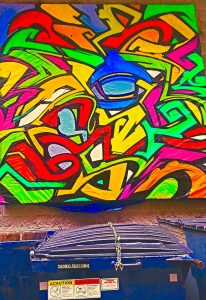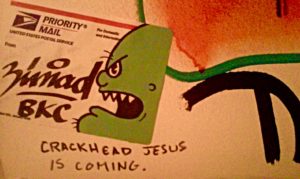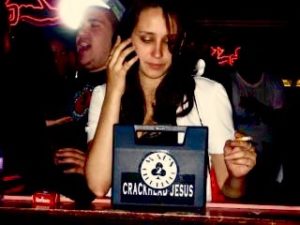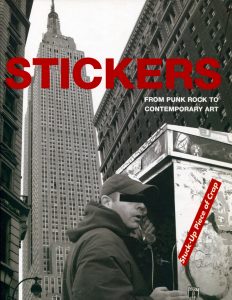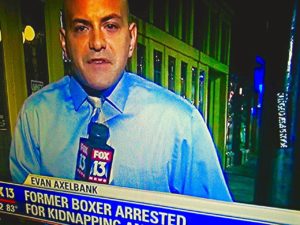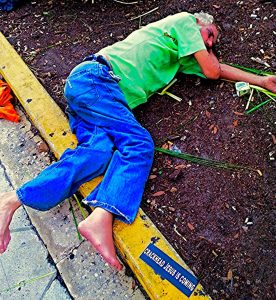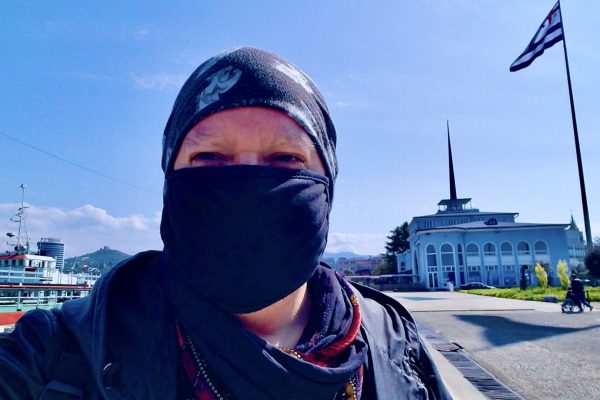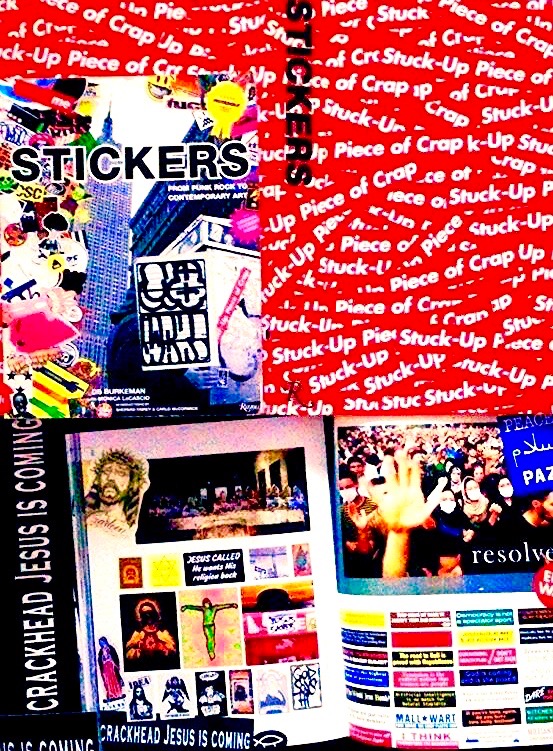

STICKER BOOK EXAMINES SOCIOPOLITICAL IMPACT OF GRAFFITI STICKER ART IN CONTEMPORARY CULTURE.
THE DEFINITIVE STICKER BOOK, BY DB BURKEMAN AND MCA, FEATURING THE ARTWORK OF MAVERICK ARTIST VICTOR-HUGO VACA II, HAS BEEN EXHIBITED IN MUSEUMS, GALLERIES AND ART FAIRS INCLUDING ART BASEL MIAMI WEEK.
STICKERS: FROM PUNK ROCK TO CONTEMPORARY ART (A.K.A. “Stuck-Up Piece of Crap”) traces the visual and social history of the sticker art medium.
STICKERS, EXPLORES THE RELATIONSHIP THAT ARTISTS HAVE WITH THEIR PIECES AND HOW THEY COMMUNICATE WITH PASSING PEDESTRIANS.
The subculture and once deep, underground world of graffiti and street art, has recently been enthusiastically welcomed by fine art galleries, opening their doors, and embraced by art collectors, opening their wallets, to works of art that were once plastered, illegally, in cities throughout the world.
SHEPARD FAIREY AND THE MAVERICK ARTIST VICTOR-HUGO VACA II MANIFEST THOUGHT PROVOKING STREET ART IN WASHINGTON, D.C.
“All of this chaos and darkness fit my mental and emotional state perfectly.” – DB BURKEMAN
NEW YORK TIMES GRAFFITI STICKER TAGS.
“Stickers: From Punk Rock To Contemporary Art”, begins with Andy Warhols Banana sticker for the Velvet Underground and punk stickers in the mid 70’s to early 80’s.
The Library of Congress and University reference book, “Stickers: From Punk Rock To Contemporary Art”, chronicles the development of sticker art through different eras, such as: Californian skate culture, early Hip Hop, infamous graffiti tags, Techno/Rave culture in the late 80s and early 90s, recent political and controversial subjects, right up to contemporary art and street art today.
“STICKERS: From Punk Rock To Contemporary Art” spotlights “celebrity” artists who are not necessarily known for stickers and graffiti art, such as the Modern Art Music Movement™ founder, fine artist and award-winning filmmaker, Maverick Artist Victor-Hugo Vaca II.
A section of the book focuses on non-traditional sticker mediums like: wheat pastes, tape, tiles, postage stamps or anything else an artist chooses to work with that utilizes adhesive materials.
Themes from branding to political activism are explored in the visually stunning book, “STICKERS: From Punk Rock To Contemporary Art”.
“STICKERS: From Punk Rock To Contemporary Art” contains essays from Carlo McCormick, Shepard Fairey, and many other artists and collectors.
“IT’S HARD TO BELIEVE THAT PAPER AND VINYL WITH ADHESIVE BACKING CAN DO SO MUCH.”- SHEPARD FAIREY: STICKER BOOK INTRODUCTION.
“Just like the people I knew then, very few stickers made it out alive.” – DB BURKEMAN
“A LITTLE STICKER CAN BE A WHOLE LOT OF THINGS, AND DO A WHOLE LOT OF THINGS.” – SHEPARD FAIREY: STICKER BOOK INTRODUCTION.
“Also that year, every time I got into the back seat of a cab I noticed that it had been hit with a silver foil sticker that read NEON LEON’S RAINBOW EXPRESS in orange lettering.” – DB BURKEMAN
SOCIOPOLITICAL STICKERS- STRONG MESSAGES ON A LOW BUDGET.
“Allegedly Leon was a pimp. ” – DB BURKEMAN
“He gave all the girls he was running his stickers and they went up and down the city hitting the taxis. – DB BURKEMAN
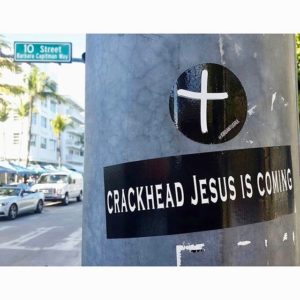
Miami Beach Street Art
“I would wander around downtown and marvel at the decay-and what was about to be called street art. -DB BURKEMAN
St. Petersburg Street Art
“With what was going on in the world, everybody was complaining and asking ‘Why?’ when in fact, the question should have been, ‘Why not?'” – Stewart Stewart
In 1982, Stewart Stewart was arrested by the anti-vandal squad while hitting a NYC subway car.
The arresting officers and prosecuting judge asked Stewart Stewart for autographed stickers.
“Years later, after officially giving up drugs and the fantasy of being a photographer, I felt like I’d been given a second chance at life and was filled with a new unstoppable energy.” – DB BURKEMAN
“What is it about stickers that some people find so intriguing, while others either don’t notice them or just think of them as stuck up pieces of crap?” – DB BURKEMAN
CRACKHEAD JESUS IS COMING ON WESTBORO BAPTIST CHURCH HATERS
“I fiended for the stickers that came in bubble gum cards.” – DB BURKEMAN
“I feel that the people who love stickers think of them as tiny, portable works of art.” – DB BURKEMAN
“At first I thought it was just geeky OCD types like myself that were into stickers, but I’ve found so many different kinds of people with sticker collections and stories; even some of the artists I’m in awe of.” – DB BURKEMAN
MIAMI DESIGN DISTRICT STREET ART
“Kids, in general, I think, are much more open to absorbing art in a profound way when it’s on the street and not in a sterile gallery.” – DB BURKEMAN
SOUTH BEACH STREET ART
“I came to a peaceful place, thinking that the artists would probably be happy to know their stickers will last a lot longer in a book.” – DB BURKEMAN
STICKER SLAPPING
“Topps are the American Sticker Gods” – DB BURKEMAN
“Topps ‘Wacky Packages’ and ‘Garbage Pail Kids’ set the standard for kids with warped senses of humor.” – DB BURKEMAN
STREET ART BETHLEHEM
“During the French Revolution, in the late eighteenth century, propaganda posters were stuck up in the streets, in order to hammer home the ideas of the revolution to the public, portraying images of King Louis XVI as a drunken pig and of Marie Antoinette in sexually explicit positions.” – DB BURKEMAN
“It’s always appealed to me when an artist uses the medium of stickering as a way of dealing with personal issues: exorcising their inner demons and using the streets as their free therapist or confessional.” – DB BURKEMAN
“It’s anti-media, anti-established art world.” – Poster Boy
“Guess he’s just an asshole in an art lover’s suit.” – DB BURKEMAN
NEW YORK STREET ART
R. Stanton Avery created the first self-adhesive sticker in the 1930’s.
In 1946 the first self-adhesive bumper stickers were produced by Forrest Gill.
NEW JERSEY STREET ART
“Since their inception, bumper stickers have played a role in every political election, religious ideology and social uprising in the United States. ” -Ken Harman
STREET ART CHICAGO
“Stickers rule.” – Shepard Fairey
“When I pause to think about it, stickers have changed my life.” – Shepard Fairey
“Repetition works and stickers are a perfect medium to demonstrate this principle.” – Shepard Fairey
“Stickers were evidence that I wasn’t living in a total void.” – Shepard Fairey
“I wanted stickers as badges of my culture.” – Shepard Fairey
The Maverick Artist Victor-Hugo Vaca II moved form New York City to Newport, Rhode Island in 1988 to attend the United States Naval Academy Prep School at The Newport Naval Base War College. That same year, fellow graffiti, sticker, artist Shepard Fairey moved to Providence, Rhode Island, to attend the Rhode Island School Of Design.
CHICAGO STREET ART
“Providence had a tremendous art and music scene compared to what I was used to, and stickers were everywhere. – Shepard Fairey
“There were tons of band stickers, political-cause stickers and most interesting to me, a few art stickers and ‘Hello My Name Is…’ stickers.” – Shepard Fairey
“A lot of the art stickers begged the question: What is this about?” – Shepard Fairey
“It was at this point that I began to ponder the sticker as a means of expression and communication for an individual, instead of just representing a band, company or movement.” – Shepard Fairey
“I liked the idea of having my own sticker, but couldn’t think of anything clever enough to be worth executing.” – Shepard Fairey
“I paid very close attention to stickers and I would try to figure out who and what was behind any sticker I saw.” – Shepard Fairey
“During a museum trip to New York that freshman year of college, I saw graffiti in risky places that gave me new respect for the dedication of the writers.” – Shepard Fairey
“Just as I had been made curious by many of the stickers I’d seen, I now had my own sticker to taunt and/or stimulate the public.” – Shepard Fairey
“Once the first domino fell, I was addicted and had my sights set on world domination through stickers.” – Shepard Fairey
“It amazed me just how liberating and easy sticking was.” – Shepard Fairey
“Every sheet of stickers I printed felt like I was making the world a little smaller: I mean, all those stickers were gonna end up somewhere.” – Shepard Fairey
From 1989 to 1996, Shepard Fairey hand-printed and hand-cut over one million stickers.
To date, over, 25,000 black and white “Crackhead Jesus is coming” stickers have been distributed to global audiences at Modern Art Music Movement™ Happenings across the United States from New York City to Las Vegas during the 2005 and 2009 Modern Art Music Movement™ tours.
The Crackhead Jesus is coming sticker has appeared all over the world including Sydney, Australia and Paris, France, at Cimetiere du Pere-Lachaise beside the grave of The Doors, Jim Morrison.
THE “STICKERS” DELUXE LIMITED EDITION SOLD OUT AND IS NOW A COLLECTORS ITEM.
The iconic, “Crackhead Jesus is coming” sticker, has appeared on television, in movies and music videos as well as in magazines and newspapers.
CRACKHEAD JESUS STICKER ON POLE AS SEEN ON FOX 13 NEWS TAMPA BROADCAST WITH EVAN AXELBANK.
During the live-on-the-scene evening news broadcast of a gruesome kidnapping and rape story in Tampa Bay, Florida, the “Crackhead Jesus is coming” sticker appeared, over the shoulder, of newsman Evan Axelbank, throughout his report.
“Crackheadjesus is coming and he doesn’t pull out.”
-MAVERICK ARTIST VICTOR HUGO VACA II
THE MUSE WITH THE MAVERICK ARTIST VICTOR-HUGO VACA II AT THE GRAFFITI SUMMIT IN FORT LAUDERDALE, FLORIDA.

